Recent Storm Damage Posts
Restoring Homes After Winter Storm Damage in Northwest Phoenix/Anthem
1/28/2025 (Permalink)
Winter storms can create unexpected challenges for homeowners in Northwest Phoenix and Anthem. While Arizona isn’t known for harsh winters, occasional cold snaps and storms can lead to damage that requires immediate attention. From frozen pipes to wind-damaged roofs, winter weather can disrupt the comfort and safety of your home.
When pipes freeze due to dropping temperatures, they often burst, leading to water damage in walls, ceilings, and floors. Prompt action is necessary to mitigate the effects and prevent secondary issues like mold growth. High winds during winter storms can also loosen shingles, damage siding, or topple trees, causing structural problems that need expert care.
Professional restoration services are equipped to handle these challenges efficiently. Restoration teams are trained to address water intrusion, structural repairs, and drying processes, ensuring your home is safe and habitable. Advanced tools, such as dehumidifiers and air movers, help dry affected areas and prevent long-term damage.
Preparing your home for winter storms is important. Insulating pipes, maintaining gutters, and trimming overhanging tree branches can reduce the risk of damage. However, if your property is affected by unexpected winter weather, restoration professionals are ready to assist with quick, efficient solutions.
Don’t let winter storm damage disrupt your life. Professional teams specialize in restoring properties to their pre-damage condition, giving you peace of mind when you need it most.
Reach out (623) 780-9111 today for expert winter storm restoration services to protect and restore your home.
Stay safe and protect your home during dust storm season
7/25/2024 (Permalink)
Dust storms, or haboobs, are a common occurrence in Northwest Phoenix and Anthem. Here are some tips to prepare your home for dust storm season:
Seal Doors and Windows: Ensure that all doors and windows are properly sealed to prevent dust from entering your home.
Maintain Your HVAC System: Clean or replace air filters regularly to keep indoor air clean.
Create a Dust Storm Kit: Include items like masks, goggles, and a first-aid kit to protect yourself during a storm.
Secure Outdoor Items: Bring in or secure outdoor furniture, decorations, and trash cans to prevent them from being blown away.
Stay Informed: Monitor local weather forecasts and be prepared to take action if a dust storm is approaching.
By taking these precautions, you can protect your home and family during dust storm season.
9 Ways to Protect Your Home During the Monsoons
1/17/2024 (Permalink)
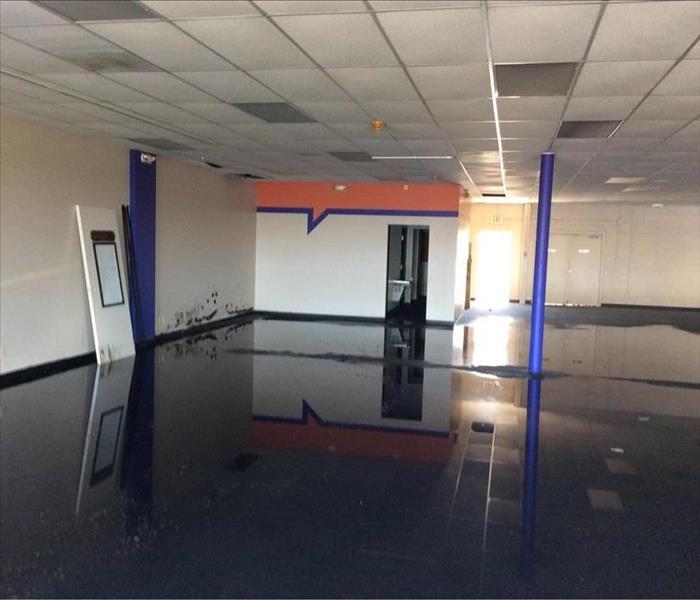 However, if the monsoon season does take a toll on your property, SERVPRO® of Northwest Phoenix/Anthem is here to assist.
However, if the monsoon season does take a toll on your property, SERVPRO® of Northwest Phoenix/Anthem is here to assist.
As the dark clouds of monsoon roll in, they bring not just torrential rain, but also the potential for severe damage to your property. At SERVPRO® of Northwest Phoenix/Anthem, we understand the importance of being prepared for these seasonal storms. We've compiled a 9-point checklist to help you weatherproof your home and avoid water damage during monsoons effectively.
1. Check Your Roof
Inspect your roof for signs of wear or damage, which can lead to leaks during heavy monsoon rains. Pay particular attention to worn-out shingles or tiles, and get any damages repaired by professionals.
2. Clean the Gutters and Downspouts
Blocked gutters and downspouts can cause water to overflow, leading to structural damage. Clean them thoroughly and ensure they are functionally guiding water away from your home’s foundation.
3. Inspect Window and Door Seals
While rain is lashing against your windows and doors, faulty seals can easily allow water into your home. Re-caulk windows and doors as necessary to ensure a waterproof seal.
4. Install Surge Protectors
Monsoons come with the risk of lightning and power surges. Protect your electrical appliances by installing surge protectors.
5. Protect Your HVAC Systems
Ensure your HVAC system, which includes your Air Conditioning units, have been checked and serviced. Cover outdoor units during surges of heavy rain to avoid damages.
6. Trim Overgrown Trees and Branches
Loose branches and weak trees can easily fall during heavy downpours and winds, posing a threat to your home. Trim back branches close to your home and consider removing any unstable trees.
7. Secure Outdoor Items
Secure or store away outdoor furniture, gardening tools, and other loose items that could be picked up by the wind and pose a safety hazard.
8. Prepare an Emergency Plan
Have an emergency action plan in place for you and your family, which includes knowing where to seek shelter during a storm and stocking up on essential supplies.
By following these steps, you can significantly reduce the risk of monsoon-related damage. However, if the monsoon season does take a toll on your property, SERVPRO® of Northwest Phoenix/Anthem is here to assist. We specialize in restoring properties from storm and water damage, making it "Like it never even happened." Stay safe, stay prepared, and remember, our SERVPRO® team is just a call away.
Shielding Your Home in Phoenix, AZ: A Guide to Storm-Proofing
9/12/2023 (Permalink)
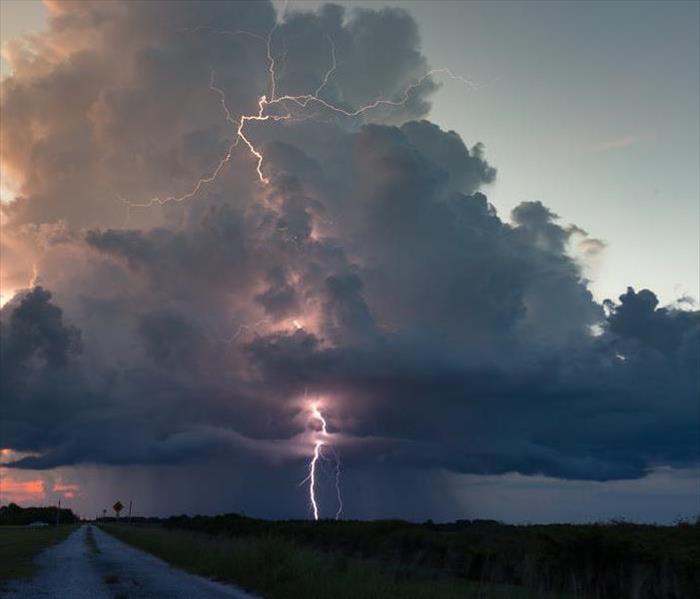 While Phoenix, AZ, is renowned for its sunny climate, occasional storms can still bring unexpected challenges.
While Phoenix, AZ, is renowned for its sunny climate, occasional storms can still bring unexpected challenges.
While Phoenix, AZ, is renowned for its sunny climate, occasional storms can still bring unexpected challenges. Protecting your home from these weather events is essential, particularly when it comes to storm-proofing your windows and doors. In this blog, we'll explore practical strategies to safeguard your home against storms, ensuring that your windows and doors remain secure and your property remains protected.
Understanding Phoenix's Storm Challenges
Though Phoenix may not experience hurricanes or blizzards, monsoon season can bring intense dust storms, heavy rains, and even microbursts. These weather phenomena can place considerable stress on your windows and doors. Storm-proofing measures can help prevent damage and maintain the safety and comfort of your home.
Reinforce Windows with Impact-Resistant Glass
Investing in impact-resistant glass for your windows can significantly enhance storm protection. This type of glass is designed to withstand high winds, flying debris, and potential impacts during severe weather. It not only shields your home from damage but also reduces the risk of shattered glass causing harm to occupants.
Install Storm Shutters
Storm shutters provide an additional layer of defense for your windows during storms. These shutters can be easily closed before a storm arrives, preventing debris from hitting and damaging your windows. They are available in various styles, including accordion, roll-down, and colonial, allowing you to choose the option that suits your home's aesthetic.
Seal and Weatherstrip Doors
To prevent water infiltration and drafts during storms, ensure that your doors are properly sealed and weatherstripped. This not only improves energy efficiency but also prevents moisture from entering your home during heavy rains. Regularly inspect and replace weatherstripping as needed to maintain an effective barrier against the elements.
Reinforce Door Frames
Strong winds can exert pressure on door frames, potentially leading to structural damage. Reinforce your door frames with additional hardware, such as heavy-duty screws and reinforcement plates. This added support can prevent doors from being forced open by strong winds.
Consider Impact-Resistant Doors
Similar to impact-resistant windows, impact-resistant doors are designed to withstand high winds and potential impacts. These doors are constructed with reinforced materials and hardware, making them more resistant to damage during storms. They come in various styles, including entry doors, patio doors, and sliding glass doors.
Trim and Prune Landscaping
Well-maintained landscaping can prevent debris from becoming projectiles during storms. Regularly trim trees and shrubs around your home to minimize the risk of branches or other objects hitting your windows and doors during high winds.
Storm-proofing your windows and doors is a proactive step towards ensuring the safety and protection of your home in Phoenix, AZ. Impact-resistant glass, storm shutters, proper sealing, and reinforcement are all valuable measures that can minimize the impact of storms on your property. By taking these steps, you can reduce potential damage, enhance your home's resilience, and enjoy greater peace of mind during stormy weather.
Assessing the Need: Does Your Business Require Flood Insurance
6/27/2023 (Permalink)
 Flood insurance is vital to keeping your business safe incase of a natural disaster.
Flood insurance is vital to keeping your business safe incase of a natural disaster.
Natural disasters, such as floods, can have a devastating impact on businesses, leading to significant financial losses and operational disruptions. One crucial consideration for business owners is whether they need flood insurance to protect their assets and ensure business continuity. In this blog, we'll explore important factors to help you assess the need for flood insurance for your business, providing valuable insights to make an informed decision.
Evaluate Your Business Location
Understand the flood risk associated with your business location by referring to flood zone maps provided by the Federal Emergency Management Agency (FEMA). These maps identify high-risk flood zones that are more prone to flooding. Assess the local climate and geographical features that could contribute to flooding, such as proximity to rivers, coastlines, or areas with high rainfall. Areas with a history of flooding or vulnerable to extreme weather events require closer consideration.
Understand Insurance Coverage
Examine your existing commercial property insurance policy to determine if it includes coverage for flood-related damages. Typically, standard policies exclude flood coverage, making separate flood insurance necessary. Research government-backed flood insurance programs, such as the National Flood Insurance Program (NFIP) in the United States. These programs provide flood insurance options for businesses located in participating communities.
Assess Potential Risks and Impact
Consider the potential financial consequences of flood-related damages to your business property, equipment, inventory, and other assets. Assess whether your business can absorb such losses without significant impact. Contemplate the potential disruption to your business operations in the event of a flood. This includes downtime, loss of productivity, damage to critical equipment, and the impact on customer service.
Regulatory Requirements and Lender Obligations
Research local regulations and requirements regarding flood insurance for businesses. Some areas may mandate flood insurance coverage based on the flood zone classification or property type. If your business has a mortgage or loan secured by the property, lenders may require flood insurance as part of the loan agreement. Review your loan terms and consult with your lender to understand their specific requirements.
Consider Risk Management and Preparedness
Assess the effectiveness of your business's flood mitigation and prevention measures. This includes building modifications, drainage improvements, and emergency preparedness plans to minimize flood-related risks. Evaluate your business's ability to maintain operations during and after a flood event. Consider the potential financial and reputational consequences of disruptions and whether flood insurance would help expedite recovery.
Determining the need for flood insurance for your business involves a thorough evaluation of various factors, including your business location, insurance coverage, potential risks and impact, regulatory requirements, and risk management strategies. By carefully considering these factors, you can make an informed decision regarding the necessity of flood insurance to protect your business assets, finances, and ensure continuity in the face of a flood event. Consulting with insurance professionals and risk management experts can provide valuable guidance tailored to your specific business needs.
Cleaning Up After a Leaking Roof
6/8/2022 (Permalink)
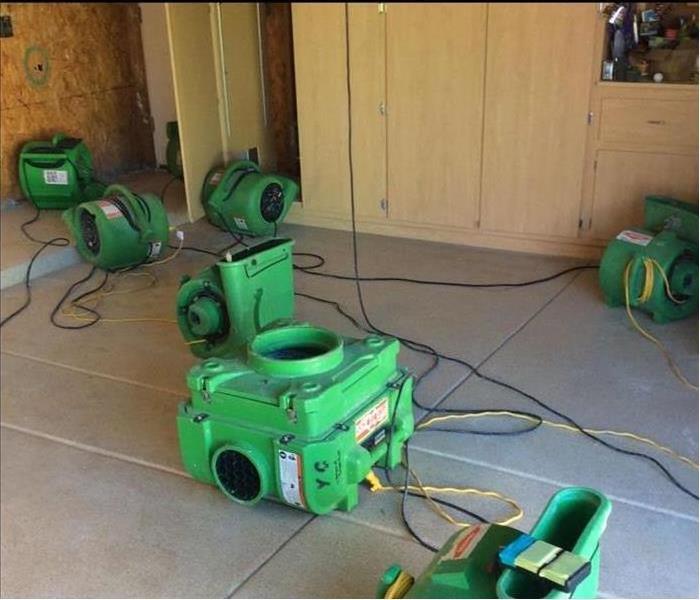 When storm or water damage occurs in your business, call our SERVPRO team. Our crew is available 24 hours a day, 7 days a week, 365 days a year.
When storm or water damage occurs in your business, call our SERVPRO team. Our crew is available 24 hours a day, 7 days a week, 365 days a year.
After A Roof Has Leaked, How Do You Clean Up?
Water stains in dropped ceilings, tracking down the wall or dripping in a hallway are all signs that your commercial building has a roof leak. Even minor exposure can be a major inconvenience. It can disrupt daily business operations in New River, AZ, and if not taken care of quickly, it can become a costly repair.
What Causes Roofing Leaks
As water flows outward from the leak point, its exact location can be challenging to identify. Some common causes include:
- Age of the roof
- Debris building up and trapping water against the roof
- Gutter backup slowing water flows off the roof
- Missing shingles that may have been ripped off in high winds
Water Damage Cleanup
Once the location of roof leak has been identified and the damaged roof fixed, it’s time to begin water damage cleanup. Depending on the site and severity of the leak, this can be extensive. Although each situation may be a bit different, some common steps must be taken.
1. Remove water-damaged materials.
• From the exterior: Shingles, tarpaper, plywood, flashing, etc.
• From the interior: Fiberglass insulation, drywall, dropped ceilings, carpeting/flooring, etc.
2. Dry water affected areas.
• If appliances or equipment were exposed to water, unplug them and let them air dry.
• Open windows if it’s less humid outside than inside.
• Use fans to speed the drying process.
• Check for mold growth.
3. Disinfect areas exposed to the water
• Wash nonporous hard surfaces such as glass, plastic, and metal with hot water and a nonammonia soap
• Disinfect all exposed surfaces including wood beams and studs with a bleach solution.
• Clean soft surfaces such as furniture, window coverings and carpeting with a disinfecting cleaner
Recovering from a roof leak and restoring roof and ceilings can be a time-consuming, complex process. Water damage restoration specialists in New River, AZ, can ensure the process is done quickly and thoroughly, allowing you to get back to business.
5 Ways To Prepare a Home for Flooding
5/16/2022 (Permalink)
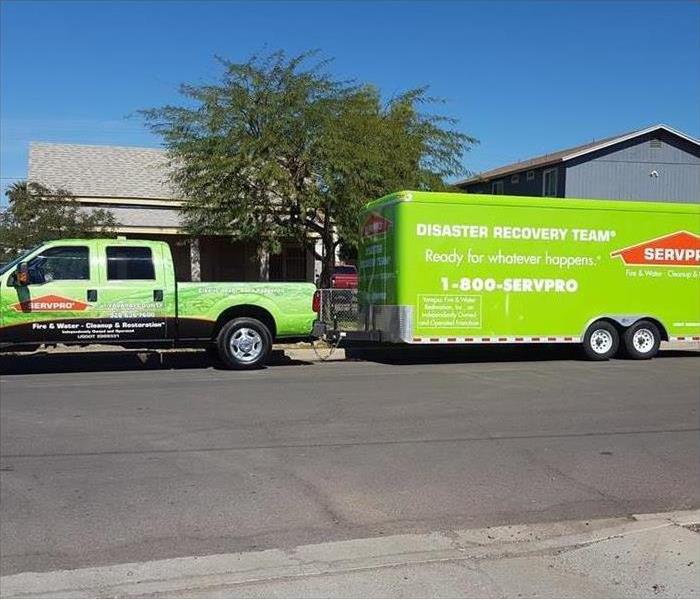 Just like the storm damaged home in this picture, we are ready at any time to help you get your home back after disaster strikes.
Just like the storm damaged home in this picture, we are ready at any time to help you get your home back after disaster strikes.
5 Steps To Flood-Proofing Your Home
With flood risks on the rise, your home in Peoria, AZ, may be at risk. Although preventing flooding may not be possible, there are ways to prepare your home and minimize the damage that a professional water and storm damage restoration company will have to repair.
1. Ensure Proper Drainage
An essential way to minimize flood damage is to ensure that the grading around your home is at the right angle. There should be a slope away from the foundation. If you have noticed pools after a rain shower, it is time to bring in some dirt. To further enhance drainage, consider doing some landscaping with mulch and plants known to have high water needs.
2. Inspect the Foundation and Basement
Even the smallest crack in the foundation may lead to big problems. Inspecting the foundation and basement windows should be on the annual to-do list. Check for any signs of leaks, cracks, broken seals, missing caulk or broken masonry.
3. Install Flooding Prevention Systems
If your home is in a high-risk area, there are different systems on the market that detect unwanted water. These are electronic devices that alert the homeowner of excess water before it becomes a major problem. Many of these can also be tied to other smart-home devices.
4. Clean Gutters and Drains
If the gutters are dirty, the rain won’t drain properly. Instead, it will push out of the sides and straight down to the foundation. For homes in areas with many trees, the gutters should be cleaned at least twice a year. Ditches and drains should also be inspected to ensure there is no blockage.
5. Keep Barriers Accessible
Once the rain starts to pour down, you may not be able to keep it out. You can slow the flow by having sandbags on-site. There are also other innovative barrier systems designed for flood prevention that are easy to use and help divert water.
While flooding may not be totally avoidable, there are ways to minimize the risk and prepare your home to battle the storm.
5 Steps To Take After Storm Damage
5/4/2022 (Permalink)
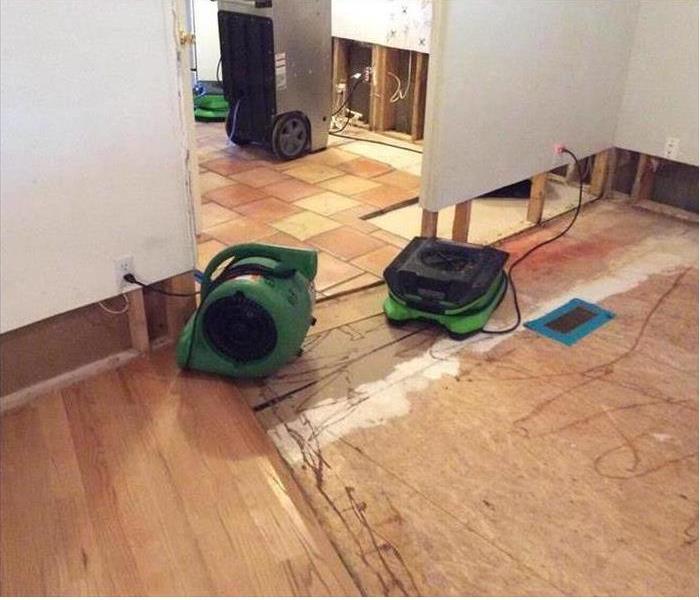 SERVPRO of Northwest Phoenix / Anthem has experience restoring Phoenix homes affected by storms and flooding. Call us!
SERVPRO of Northwest Phoenix / Anthem has experience restoring Phoenix homes affected by storms and flooding. Call us!
5 Things To Do After A Storm
Severe storms are no surprise in Norterra, AZ. While, hopefully, your home will be able to weather the storm, that isn’t always the case. If it has sustained damage, below are five storm tips to take to get your back to normal faster.
1. Assess the Damage
Once it is safe to do so, inspect the exterior and interior of the home, especially the basement and attic, for damage. Damage to look for include roof holes, missing shingles, ceiling leaks, dented gutters and broken windows.
2. File a Claim
When it comes to storm tips, contacting your insurance provider ranks high. That is especially important after a storm considering that many other homes are likely damaged. The faster you get the claim process going, the sooner an adjuster will arrive and cleanup can begin. The insurance company will also help you determine what steps should be taken next, including whether or not items can or can’t be removed from the home.
3. Document the Damage
While waiting for the adjuster to arrive, it is important to document all the damage. It is recommended to take videos and photographs of any damage. This will help reinforce your claim and may make the process move along faster.
4. Prevent Secondary Storm Damage
While your insurance will likely cover most of the damage caused by the storm, it won’t cover damage that happens after the event. If the damage sustained includes holes or broken windows, they must be tarped or boarded up to prevent additional water or other damage.
5. Contact a Restoration Company
Depending on the severity of the damage, the next call should be to a professional storm and water damage restoration company. Along with being able to assist with cleanup and restoration required from the water issue, a certified professional will also be able to mitigate the risk of mold growth and other hidden issues, ensuring your home is returned to being a safe and healthy environment.
Severe weather has a way of creating havoc. If your home sustains damage, the above storm tips may help you get back to normal faster.
What You Should Understand About Mitigation and Restoration
4/1/2022 (Permalink)
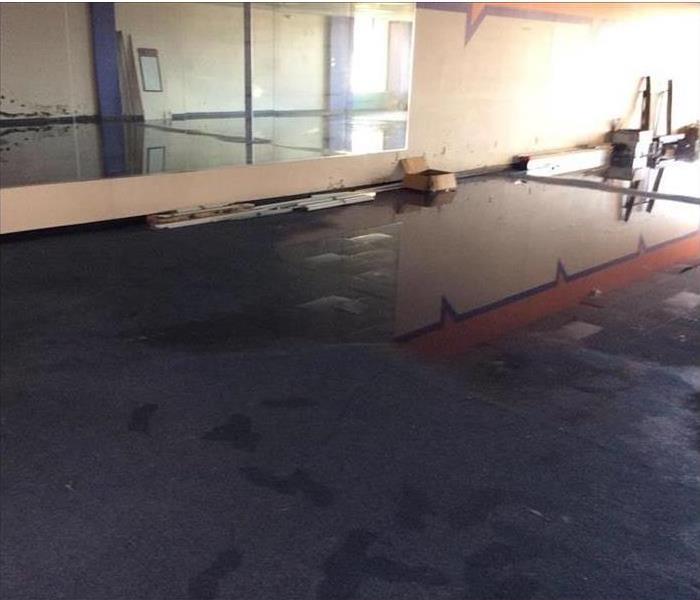 If unexpected weather damages your Peoria home or business, give SERVPRO of Northwest Phoenix / Anthem a call. We can help you.
If unexpected weather damages your Peoria home or business, give SERVPRO of Northwest Phoenix / Anthem a call. We can help you.
What You Should Know About Restoration And Mitigation
If you’re preparing your business to deal with emergencies such as floods, fires, and other potential problems, you should take the time to ensure you know about the services you’ll need in the aftermath, specifically mitigation and restoration. While these two services are often performed in close proximity to one another, they are not the same thing. These are the main differences:
- Mitigation is completed before restoration can commence.
- Restoration is often a much lengtheir process than mitigation efforts.
- However, both may be completed by your chosen flood cleanup company.
Mitigation
Mitigation consists of efforts made by your restoration company to prevent further damage from occurring to your building in the aftermath of a disaster. For example, after a flood, a flood cleanup company in Peoria, AZ, will often dry out carpets and personal belongings before getting to work on actual repairs. This is so that standing water and waterlogged carpets won’t cause further damage to floors, walls and other parts of your business premises while restoration is underway later.
Restoration
Restoration can only be done after mitigation is complete, during which your restoration company removes damaged materials from your building and replaces them entirely. While mitigation work is to prevent further damage, restoration gets rid of materials and belongings that could not be saved and helps to get your business back to normal. Depending on the amount of work that needs to be done, this step can take weeks.
Of course, none of this is possible without selecting a reliable cleanup company to take care of your business. The best way to ensure you’ll have the services you need on hand when you need them the most is to contract a company for your business. This means professionals will be at your business as soon as possible when flooding, fire or storm damage does occur, so you’ll experience less downtime and can get business booming again in no time.
5 Tips for Maintaining Your Roof
1/18/2022 (Permalink)
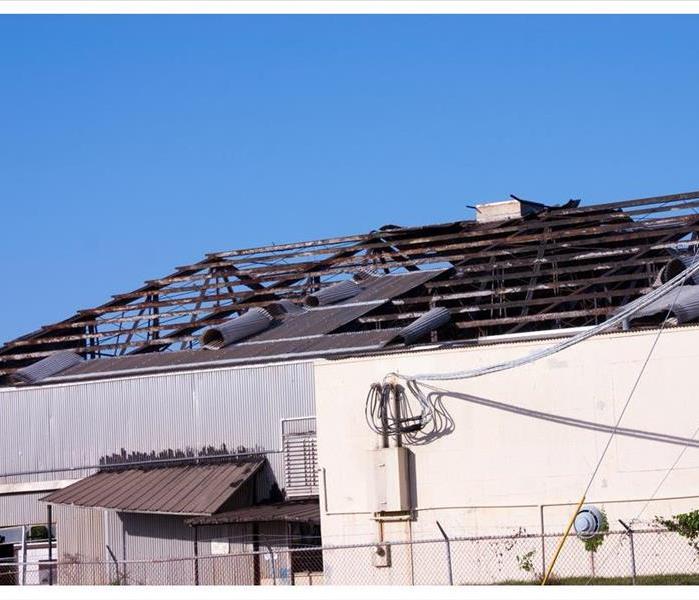 If you find that the roof of your business has storm damage, call SERVPRO, we are ready to take care of your case.
If you find that the roof of your business has storm damage, call SERVPRO, we are ready to take care of your case.
Roof Maintenance: 5 Points To Keep In Mind
If you own a business in Peoria, AZ, you may be worried about roof damage to your commercial property. Fortunately, there are a number of things you can do to help keep the roof of your business in working order.
1. Keeping Gutters Clean
One important step for roof maintenance is to keep your gutters clean. This can help prevent blockages that can lead to flooding and pooling water on your roof. It's best to check your gutters after storms to ensure that no debris has been washed into them.
2. Monitor the Roof’s Condition
It's also important to monitor the roof's condition on a regular basis. Look for any wind damage, loose shingles or cracked tiles. These are all things that should be taken care of as quickly as possible.
3. Regular Inspections
A regular inspection by a professional can help prevent roof damage in the long-term. These professionals can look over your roof for any signs of damage you may have missed. If found, repairs can be conducted to get the roof back into working order.
4. Trim Back Trees
Another step you can take for roof maintenance is to trim back any tree branches that could fall onto the roof. This can help prevent damage in the event a storm causes brakes in the tree limbs.
5. Conducting Repairs Quickly
In the event you do find damages or areas needing repair on your businesses roof, then a professional restoration team may be able to help. In the event of extreme damage, they may even be able to perform a full roof rebuild.
Following these steps can help reduce the possibility of roof damage to your business. Remember to keep your gutters clean to prevent flooding, inspect for cracks in shingles or roof tiles, trim back any tree branches that could fall into your business, and conduct any repairs needed as quickly as possible. If you do find the roof has storm damage, then a professional may be able to help.




 24/7 Emergency Service
24/7 Emergency Service







